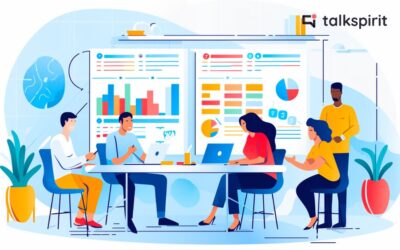Company culture eats digital transformation for breakfast.
OK the original Peter Drucker quote is culture eats strategy for breakfast, but you can fill in the blank for what culture devours because it’s the driving force of your organization, and it’s the driving force of any change you’re trying to lead.
What exactly is digital transformation? It’s not something that just happens, it’s really the strategic way your company responds to change and plans for the future. It’s how technology and company culture unite.
The world of work is going through a perpetual whirlwind of digital transformation that shows no sign of slowing down. So your business better catch up.
Technology is enabling knowledge workers to become more creative and innovative than ever at jobs that go beyond borders and nine-to-five grinds.
It’s important to remember this constant digital transformation is causing a cultural shift that you can’t ignore either. So much of new tech adoption comes down to its effect on company culture and that culture’s response to it. If your team isn’t ready to leverage new tools and creative solutions, you’re in for a bumpy ride.
How can you prepare your company for the future of work? How can you adopt a transformation strategy in your culture and in growing your team? talkSpirit dives into the answers today!
How to attract talent that is ready for change
Embracing technology empowers you to hire the best employees anywhere in the world. Your ideal candidates actually want to work with the newest shiny things. Particularly if you are looking to recruit and retain the under-35 crowd, millennials differ from previous generations who are slow to adopt technology. This is a generation that loves to try out new tools and relishes all the benefits they bring.
This Insta-gratification bunch has no patience for memorizing Excel formulas, they expect integrated workflows that suit their specific needs. And they certainly don’t expect to have to upload, download, and send bulky files back and forth over convoluted email chains. They want hands-on team collaboration in the cloud that they can access anywhere, anytime, and they want tools that are simple, effective, and easy to use. And this BYOD (bring-your-own-device) age expects to get the same experience on whatever gadget they feel like working from today.
Knowledge workers in particular look at tools as an extension of what they really want in a workplace — collaboration, autonomy, and transparency.
Millennials are now the largest part of the labour force, and they want to feel a part of something bigger. They may work on just one piece — and they want ownership of and credit for that piece — but they want to see how their roles fits into the grand scheme of things, including the strategy and direction your company is headed.
Millennials are firm believers in loving what they do, striving for work-life balance or even work-life fusion. This tech-savvy generation looks for tools that help automate and create that balance, as well as keep everyone up-to-date in continual, yet asynchronous communication.
Raised by Google, this group also expects text-based search that connects all these tools and returns crucial information.
Of course, recruitment and retention are important parts of building a company culture that responds to digital transformation. You can talk about tools to attract talent, but you also have ask the right questions to make sure you are looking for the right new teammates:
- Ask them about a time — work-related or not — when they had to adapt fast to an unexpected change.
- Ask them about their intrinsic motivators. Listen for for clues like “love to learn new things” or “problem-solving.”
- For any prior work experience, ask them for examples of measuring and quantifying that work, and how it supported overall business or team goals.
- Ask about how they enjoy communicating as a team.
- What’s their favourite productivity tool? Again, the right answer doesn’t have to be business software, just any tool they rely on.
None of these questions are about the specific role because a lot of that can be taught, but a certain kind of pivoting personality is innate and should be sought after in the ever-evolving future of work.
Internal communicators aid collaborative digital transformation
Once you’ve hired the right changemakers, you need to cultivate their loyalty and motivators. One way to do that is through an enterprise social network like talkSpirit. Yes, this all sounds like a lot for one tool to accomplish, but a tool is precisely the way to bring structure to asynchronous, collaborative work and to steer your company through digital transformation. Talkspirit does all this by reinforcing company culture and team building through transparent communication and project management.
Nowadays, with so many ways to interact at work, we run high risk for fragmented communication and channel overload. Our problem becomes not just who to contact but how to contact them. Talkspirit fosters collaboration in Groups, where anyone can see what’s going on and jump into the conversation. You can organize Groups by topic, project, department, office location, or anything you want. And you can get notifications from the third-party tools you integrate with, all in one place.
Groups give context to all you do. Many orgs are shifting from email to popular chat-apps like Slack — which are great when you’re just starting. The problem is that, as your team increases, so do the simultaneous, asynchronous conversations. Channels grow, oversight shrinks, and, before you know it, you’re getting dizzy dealing with threads within conversations within conversations, oh my! While that way of communicating is quick and great for swift decision making and brainstorming, it relies on being there on that actual moment in time.
Group functionality like within Talkspirit gives you the context you need. Groups are actually an addition to chat, as they allow for more concrete project management with actual context around it. Collaboration is achieved through actual posts, that allow for threaded conversations. New people can easily see what has already been done and join in. This all helps people stay on topic, avoiding line-by-line conversations.
You can use Talkspirit to share files and links and to work in conversations toward collective collaboration on urgent and ongoing issues. You can talk strategically, proactively, and — most important to your millennial hires — transparently. It lets your team stay on task, on topic, and be productive.
Tools like Talkspirit are especially essential to onboarding. An internal social network connects people who know how to do things with those still at the learning stage. It’s a place where newbies can easily find who does what and check on the status of projects. Talkspirit was built for knowledge capturing and process discovery. Whenever new employees set foot in an organization, it’s always challenging to get up to speed. Even the simplest things like the WiFi password are challenging. With Talkspirit, you’re able to create a special group, dedicated to new employees. Here, you can drop useful files such as passwords, FAQs, forms, you name it. What’s more, new employees can easily drop questions and get to know each other in a comfortable digital space.
One problem with asynchronous communication — that can be super overwhelming and time-consuming for both new and old teammates — is that it becomes difficult to find what you’re looking for, scattered across a plethora of tools. With Talkspirit, you can search across the platform for any files, discussions, messages, and Groups surrounding a single topic, and share the results with all the interested parties. And you can view them on any device.
Successful business transformation comes from cultural buy-in, transparent communication, and team collaboration in the same direction. Like any positive change, it’s about bringing the right people and the right tools together.
What positive response to digital transformation have you witnessed? What have you learned from it? Please share in the comments below, or tweet your tips to us at @talkspirit and @jkriggins!



